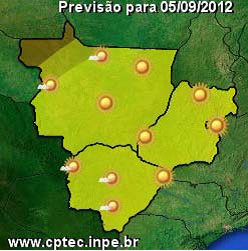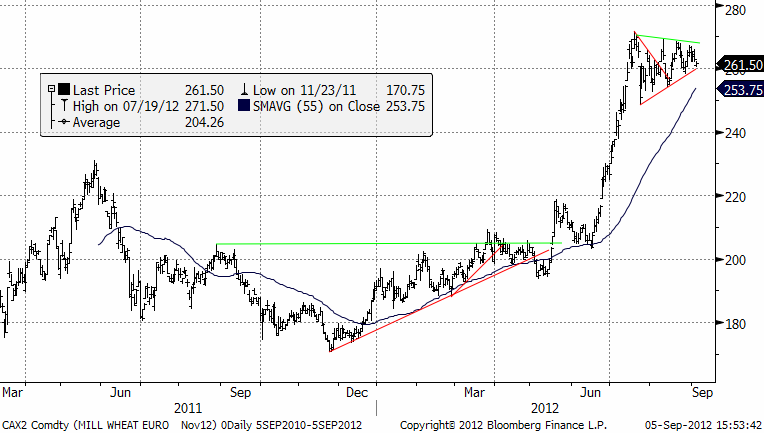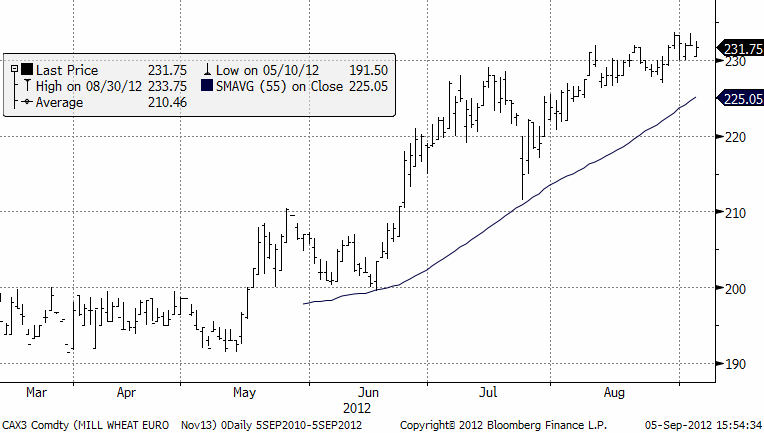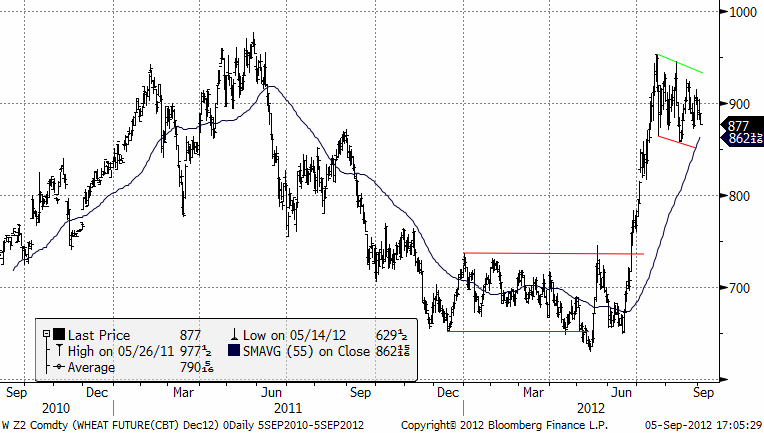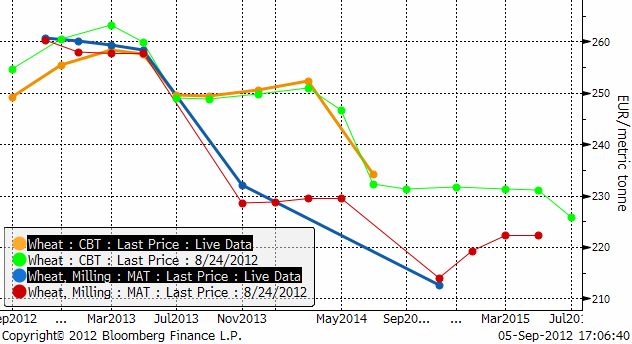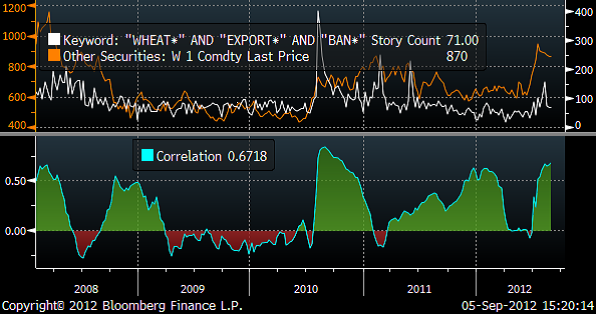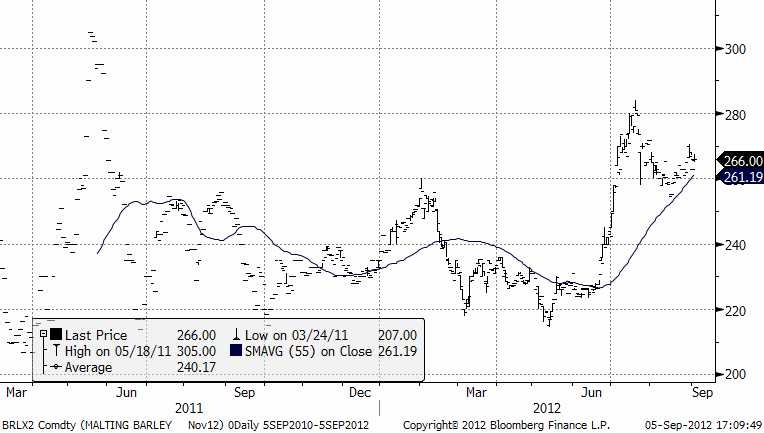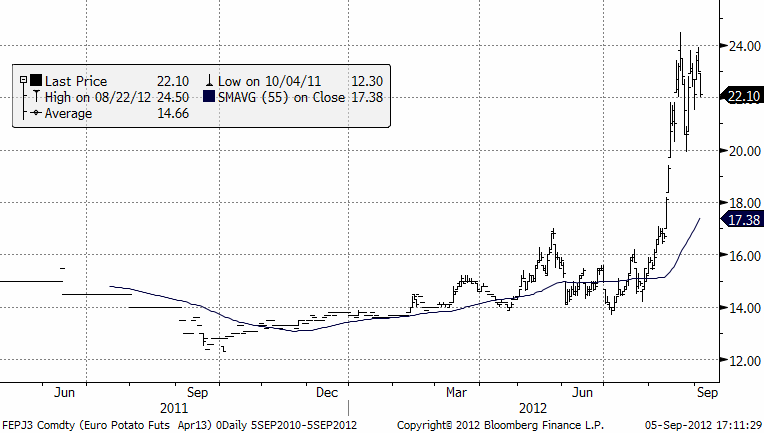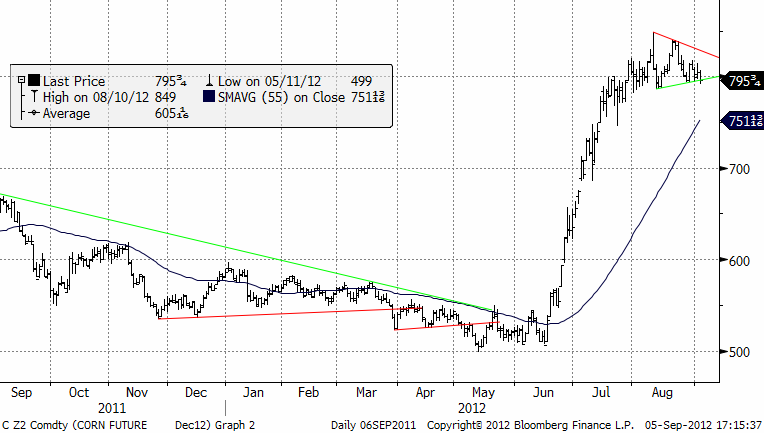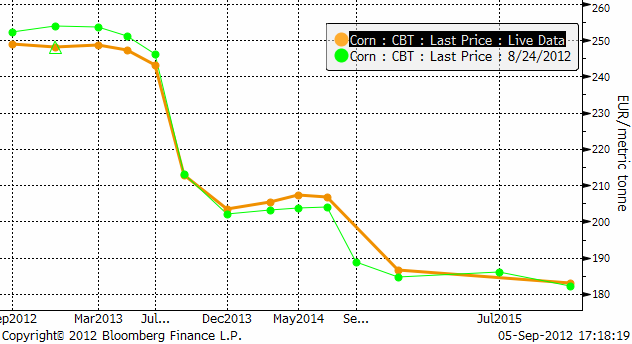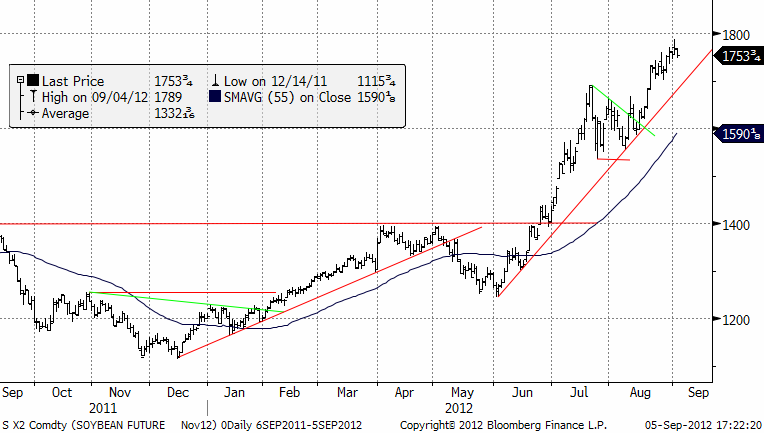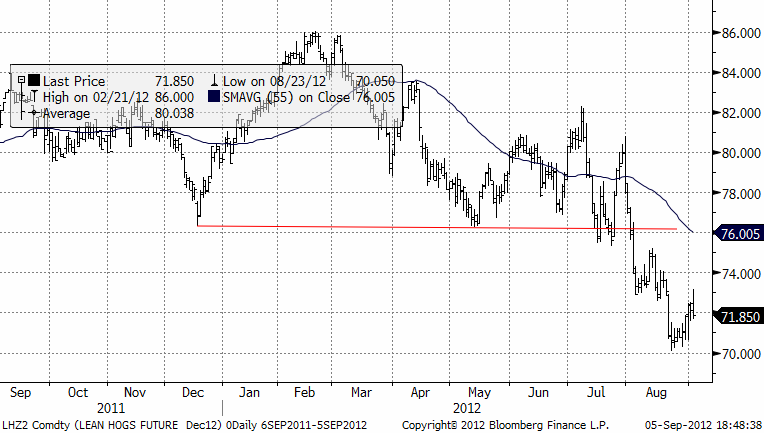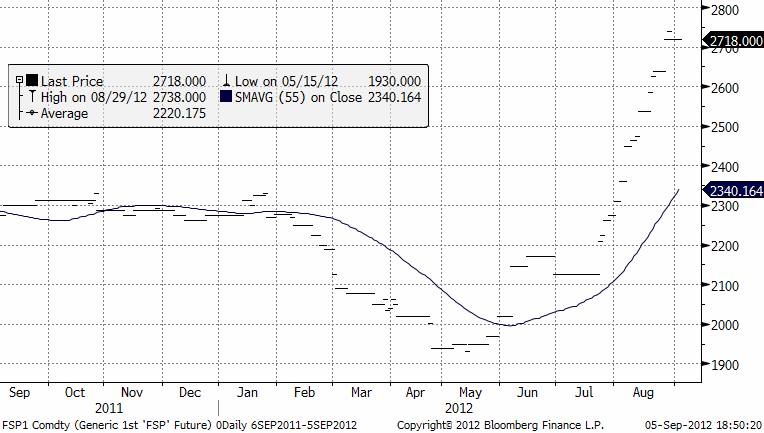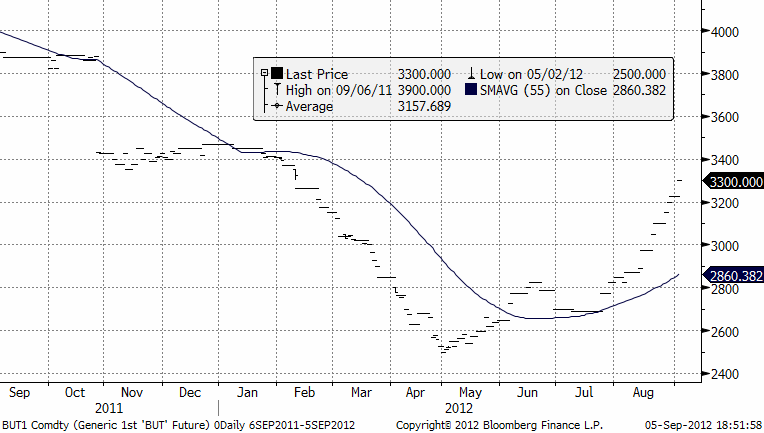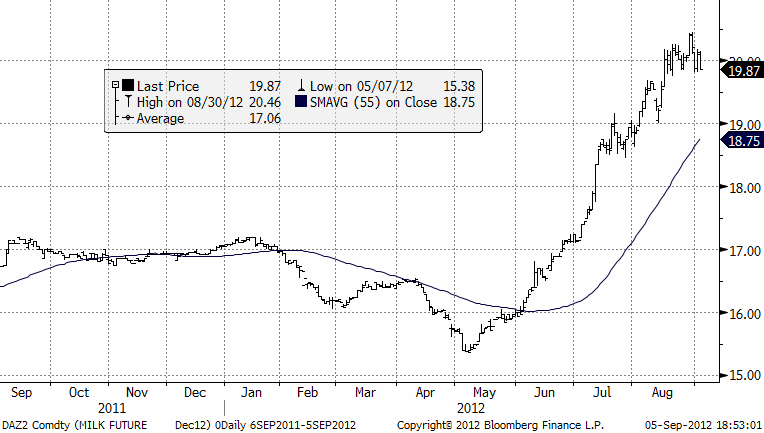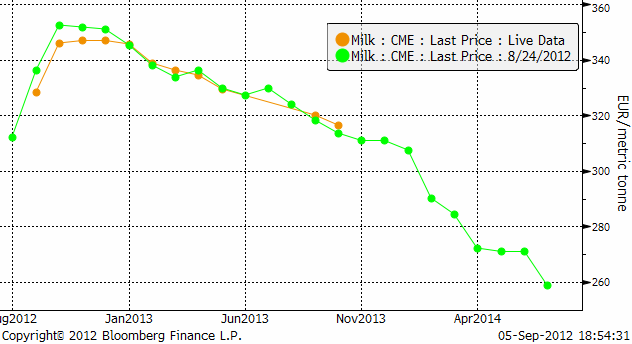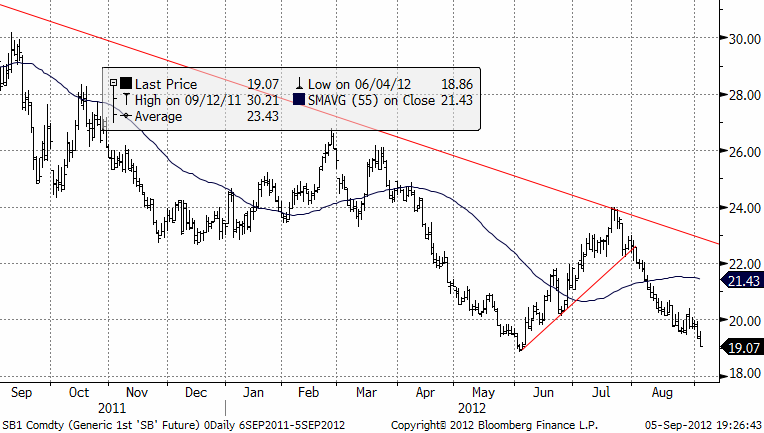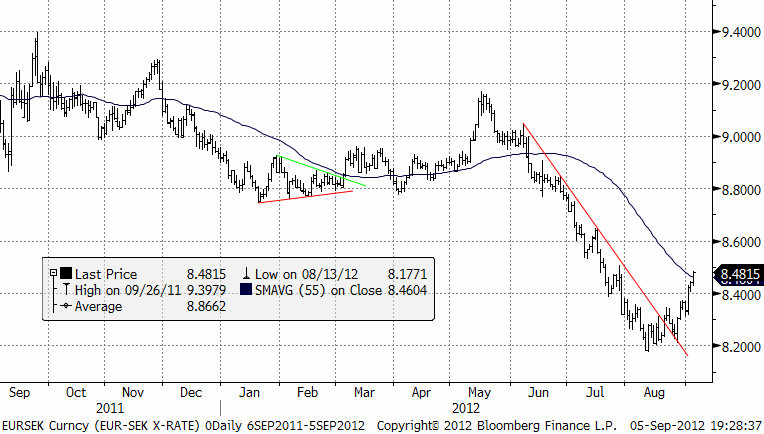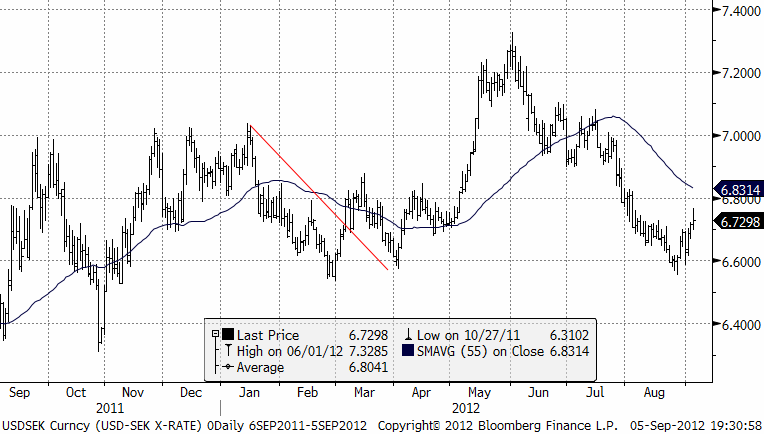Analys
SEB Jordbruksprodukter, 6 september 2012
 Det har varit en händelsefattig vecka. Priserna har rört sig ”sidledes” till stor del. Nästa vecka släpper USDA WASDE-rapporten för september och det lär vara en flau marknad till dess. Den 4 september meddelade den tyska terminsbörsen EUREX att man startar handel i vasslepulver. Handeln startar den 28 september. Terminskontrakten avser 5 ton, dvs samma storlek som de tidigare terminskontrakten på smör och skummjölkspulver. Underliggande index, som terminerna avräknas kontant mot, är
Det har varit en händelsefattig vecka. Priserna har rört sig ”sidledes” till stor del. Nästa vecka släpper USDA WASDE-rapporten för september och det lär vara en flau marknad till dess. Den 4 september meddelade den tyska terminsbörsen EUREX att man startar handel i vasslepulver. Handeln startar den 28 september. Terminskontrakten avser 5 ton, dvs samma storlek som de tidigare terminskontrakten på smör och skummjölkspulver. Underliggande index, som terminerna avräknas kontant mot, är 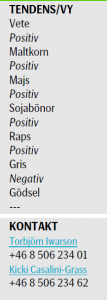 ”European Whey Powder Index”, som publiceras av Agrarmarkt Informations- Gesellschaft GmbH, i Bonn. De befintliga terminskontrakten på smör och skummjölkspulver noterades i maj 2010. Samtidigt ökar nu EUREX antal terminskontrakt som går att handla. Det kommer att finnas terminskontrakt för varje månad de närmaste sex månaderna. Därutöver kommer det att finnas terminskontrakt för varje kvartal med cykeln januari, april, juli och oktober.
”European Whey Powder Index”, som publiceras av Agrarmarkt Informations- Gesellschaft GmbH, i Bonn. De befintliga terminskontrakten på smör och skummjölkspulver noterades i maj 2010. Samtidigt ökar nu EUREX antal terminskontrakt som går att handla. Det kommer att finnas terminskontrakt för varje månad de närmaste sex månaderna. Därutöver kommer det att finnas terminskontrakt för varje kvartal med cykeln januari, april, juli och oktober.
Odlingsväder
ENSO fortsätter att surfa på gränsen till ett riktigt El Niño. SOI ligger nu på -4.7, men låg förra veckan på – 9.1. Gränsen för El Niño ligger på -8. Klimatmodeller prognostiserar att ENSO kommer att fortsätta ligga på gränsen fram till slutet av året eller in i början på 2013, för att sedan återgå till normala ENSO-förhållanden.
Kanada är helt utan nederbörd den här veckan och skörden fortskrider snabbt. Europa har också varmare och torrare väder än normalt – utom här i norra Europa. Kina har just fått en tyfon, förra veckan och har fått mer regn än normalt. Monsunen i Indien fortsätter att förbättras. Indien har nu skörd nummer två på gång och den gynnas. Vi skrev förra veckan att den förbättrade monsunen har fått läget att ljusna för grödor som majs, ris och sojabönor. Arealen sådd med ris har ökat till 32.9 miljoner hektar från 30.8 förra året. Förra årets skörd var rekordhöga 91.5 mt, enligt det indiska jordbruksministeriet.
Argentina har god nederbörd över alla väsentliga odlingsområden. Parana i södra Brasilien, där vete odlas, har också fått del av den här nederbörden. Däremot är det torrt i typiska sojaområden i centrala och norra Brasilien. Region Centro-Oeste har fått 50% av normal nederbörd. Nedanför ser vi en ögonblicksbild av vädret där.
Med utsikter om att El Niño blir ganska mild, alltså med ett ENSO som ligger på ”nästan” El Niño, kan nederbörden i Brasilien och Argentina bli mindre än vad vi trodde under våren, när det såg ut att bli en starkare El Niño. Australien har ytterst lite nederbörd – vilket är i enlighet med vad som vanligtvis sker vid ett El Niño.
Vete
Tekniskt har Matif:s novemberkontrakt fortsatt att röra sig ”sidledes” och vi tror fortfarande att nästa större rörelse blir uppåt. Den som vill ta en position redan nu, köper terminen och lägger en stop-lossorder på 258 euro. Den som placerar på lite längre sikt kan lägga stoppen på 253.90. Kursen ligger i skrivande stund på 261.50.
Det börjar ju dra ihop sig till att byta år, och då kan det vara bra att se kursutvecklingen för Matifs november 2013-kontrakt. (Kan kanske också vara ett lämpligt tillfälle att börja handla hos SEB?) Priset för nästa års skörd har som vi ser inte rört sig sidledes som november 2012, utan segat sig uppåt.
Nedan ser vi Chicagovetet med leverans i december. Den tekniska bilden indikerar samma sak här – förestående brott uppåt (förmodligen).
I diagrammet nedan ser vi terminspriserna framåt i tiden för Chicago och Matif och förändringen från 7 dagar sedan. Vi ser att backwardation har minskat i USA. Priset för leverans nästa november (2013) är nästan 20 euro per ton högre i Chicago än i Paris. Förra veckan var det 20 euro. Nu har skillnaden minskat ett par euro.
Nedan ser vi medias intresse för nyckelorden Wheat+Export+Ban. Som vi ser lite mindre intresse och också lite lägre priser. Frågan om exportstopp i Ryssland har mycket stor effekt på priset i den oroliga situation som nu råder.
Det ryska jordbruksministeriet har uppdaterat hektarskördeestimaten och de visar att hektarskörden för vete är 32% lägre än förra året. Det innebär en skörd av vete på ca 38 mt. Hektarskörden för spannmål inklusive majs är, enligt det ryska jordbruksministeriet, 27% lägre än förra året. Minns att vi i det här brevet för ca en månad sedan gjorde kalkylen 94 x 0.7 = 66 mt. 94 mt var förra årets skörd. 27% lägre skörd blir 68.6 mt. Detta är lägre än vad ministermötet i fredags resulterade i, en sänkning från 75 mt till 70. Vi har skrivit att vi tror att 70 mt är en allt för optimistisk siffra och att den kommer att följas av ytterligare nedjusteringar vid följande ministermöten. Samtidigt sänks exportpotentialen, tror vi. Det kommer en GASC-tender för novemberleverans. Om de accepterar några erbjudanden på ryskt vete eller inte, kommer att säga en hel del om hur det egentligen står till med rysk export. Sådden av höstvete i Ryssland rapporterades vara avklarad till 15%.
Vi nämnde under ”odlingsväder” att El Niño gör det torrt i Australien. Västra Australien har fått ungefär hälften av normal nederbörd. Vetet sätter ax just nu och börjar skördas i oktober. Så lite regn är naturligtvis inte bra för skördens storlek. Vi har även vad gäller Australien gjort egna El Niño-baserade beräkningar och kommit fram till att skörden ”borde” bli lägre än de 26 mt som USDA förutspådde i senaste WASDE-rapporten. Det ”borde” komma en nedjustering i WASDE-rapporten nästa vecka.
Maltkorn
Novemberkontraktet på maltkorn har funnit stöd och ser ur teknisk synvinkel ut att kunna stiga den närmaste tiden. Det är samma vy som förra veckan. Ingen förändring.
Potatis
Potatispriset tycks stabilisera sig mellan 20 och 24 euro per deciton. Det återstår att se om det är en konsolidering inför ytterligare prisuppgång över 24 euro, eller en toppformation i väntan på att se vad som händer med konsumtionen.
Majs
Vi skrev förra veckan, att ett brott nedåt inte skulle vara bra och skulle innebära att vi skulle gå ur alla positioner och rentav kanske gå kort. Nu har priset faktiskt i skrivande stund gått under stödlinjen i triangelformationen och det är en klart negativ signal.
Nedan ser vi terminskurvan framåt i tiden för majs. Vi ser att de korta kontrakten har fallit. De längre har stigit.
Måndagens crop ratings för majs var kom in med 22% i good/excellent condition, vilket är på samma nivå som förra veckan. 41% är moget. Förra året så här års var det bara 15% som var moget. 10% är skördat. Förra året var det 3%.
Sojabönor
Priset steg som väntat upp från den lilla konsolideringen i veckan som gått sedan förra veckobrevet. Den teoretiska målkursen enligt skolboken i teknisk analys ligger på 1879 cent / bu. Uppgången verkar förlora kraft och övertygelse, vilket är naturligt när det börjar närma sig målkursen. Trenden uppåt är bruten, men det är möjligt att det kommer in mer säljare vid de här nivåerna på 1800 cent.
Crop conditions var oförändrade från förra veckan. 30% är i good eller very good condition, med 38% är i poor eller very poor condition. 9% har tappat löven; det är långt över genomsnittet för de senaste fem åren, som ligger på 5%.
Brasiliens skörd ligger åtskilliga månader framåt i tiden och när det nu är torrare än normalt i sojadistrikten, framförallt i region Centro-Oeste, kan vädret där få en stor effekt. Det är viktigt att det regnar i september och framförallt i oktober för att det ska bli en god skörd. Världen behöver en rekordskörd från Brasilien efter årets missväxt i USA.
Raps
Ett brott uppåt rycker allt närmare, när trycket ökar i marknaden. Att det finns övertygade säljare på 520- nivån är dock helt klart och det kan också komma ett brott nedåt. Nästa stöd finns då på 490 euro. Man kan fortsätta ligga lång (osäkrad) och behålla en stop-loss-order på en nivå under 55-dagars glidande medelvärde. Det är det medelvärde som är inritat i nedanstående diagram.
Gris
Grispriset befinner sig i en tydlig bear market. Men tycks ha kommit till en konsolideringsfas. 70 cent per pund ser ut att vara golvet på konsolideringsområdet.
Mjölk
Priset på mjölkpulver i Nordeuropa ligger på samma prisnivå som förra veckan. Det är den första veckan sedan juli när priset inte har stigit. Priset på smör har däremot gått upp från 3150 euro per ton till 3300 euro per ton.
Nedan ser vi priset på smör, också oktoberkontraktet såsom handlat på EUREX. Priset är angivet i euro per ton.
På den amerikanska börsen CME i Chicago har priset faktiskt gått ner något för decemberleverans, som vi ser i diagrammet nedan. Priset har ändå gått upp med nästan 30% sedan bottenoteringen i maj månad.
Vad säger då marknaden just nu om priserna för leverans av mjölk i USA i framtiden? Nedan ser vi terminspriserna som kurva som de ser ut idag och hur de såg ut för 7 dagar sedan.
Vi rapporterade även i inledningen av brevet att EUREX noterar terminskontrakt på vasslepulver nu i september. Det händer onekligen mycket på mjölkmarknaden just nu.
Socker
Priset på socker, som handlades ett tag kring 20 cent, började i måndags falla igen. Det ser ut som om bottennoteringen på 18.86 cent som noterades den 4 juni ska testas igen.
EURSEK
EURSEK fortsatte som vi trodde förra veckan upp mot 8.50. Prisuppgången har fått mer och mer kraft. Kanske kommer den här uppgången att gå ända till 8.55 kr per euro.
USDSEK
Dollarn har svarat på supportområdet och hoppat upp från det. Stödet ligger vid 6.60 kr. Priset kan i första hand gå upp till 6.80. Kraften i uppgången tyder på att det kan komma en lite kraftigare uppgångsfas.
[box]SEB Veckobrev Jordbruksprodukter är producerat av SEB Merchant Banking och publiceras i samarbete och med tillstånd på Råvarumarknaden.se[/box]
Disclaimer
The information in this document has been compiled by SEB Merchant Banking, a division within Skandinaviska Enskilda Banken AB (publ) (“SEB”).
Opinions contained in this report represent the bank’s present opinion only and are subject to change without notice. All information contained in this report has been compiled in good faith from sources believed to be reliable. However, no representation or warranty, expressed or implied, is made with respect to the completeness or accuracy of its contents and the information is not to be relied upon as authoritative. Anyone considering taking actions based upon the content of this document is urged to base his or her investment decisions upon such investigations as he or she deems necessary. This document is being provided as information only, and no specific actions are being solicited as a result of it; to the extent permitted by law, no liability whatsoever is accepted for any direct or consequential loss arising from use of this document or its contents.
About SEB
SEB is a public company incorporated in Stockholm, Sweden, with limited liability. It is a participant at major Nordic and other European Regulated Markets and Multilateral Trading Facilities (as well as some non-European equivalent markets) for trading in financial instruments, such as markets operated by NASDAQ OMX, NYSE Euronext, London Stock Exchange, Deutsche Börse, Swiss Exchanges, Turquoise and Chi-X. SEB is authorized and regulated by Finansinspektionen in Sweden; it is authorized and subject to limited regulation by the Financial Services Authority for the conduct of designated investment business in the UK, and is subject to the provisions of relevant regulators in all other jurisdictions where SEB conducts operations. SEB Merchant Banking. All rights reserved.
Analys
Tightening fundamentals – bullish inventories from DOE

The latest weekly report from the US DOE showed a substantial drawdown across key petroleum categories, adding more upside potential to the fundamental picture.

Commercial crude inventories (excl. SPR) fell by 5.8 million barrels, bringing total inventories down to 415.1 million barrels. Now sitting 11% below the five-year seasonal norm and placed in the lowest 2015-2022 range (see picture below).
Product inventories also tightened further last week. Gasoline inventories declined by 2.1 million barrels, with reductions seen in both finished gasoline and blending components. Current gasoline levels are about 3% below the five-year average for this time of year.
Among products, the most notable move came in diesel, where inventories dropped by almost 4.1 million barrels, deepening the deficit to around 20% below seasonal norms – continuing to underscore the persistent supply tightness in diesel markets.
The only area of inventory growth was in propane/propylene, which posted a significant 5.1-million-barrel build and now stands 9% above the five-year average.
Total commercial petroleum inventories (crude plus refined products) declined by 4.2 million barrels on the week, reinforcing the overall tightening of US crude and products.


Analys
Bombs to ”ceasefire” in hours – Brent below $70

A classic case of “buy the rumor, sell the news” played out in oil markets, as Brent crude has dropped sharply – down nearly USD 10 per barrel since yesterday evening – following Iran’s retaliatory strike on a U.S. air base in Qatar. The immediate reaction was: “That was it?” The strike followed a carefully calibrated, non-escalatory playbook, avoiding direct threats to energy infrastructure or disruption of shipping through the Strait of Hormuz – thus calming worst-case fears.

After Monday morning’s sharp spike to USD 81.4 per barrel, triggered by the U.S. bombing of Iranian nuclear facilities, oil prices drifted sideways in anticipation of a potential Iranian response. That response came with advance warning and caused limited physical damage. Early this morning, both the U.S. President and Iranian state media announced a ceasefire, effectively placing a lid on the immediate conflict risk – at least for now.
As a result, Brent crude has now fallen by a total of USD 12 from Monday’s peak, currently trading around USD 69 per barrel.
Looking beyond geopolitics, the market will now shift its focus to the upcoming OPEC+ meeting in early July. Saudi Arabia’s decision to increase output earlier this year – despite falling prices – has drawn renewed attention considering recent developments. Some suggest this was a response to U.S. pressure to offset potential Iranian supply losses.
However, consensus is that the move was driven more by internal OPEC+ dynamics. After years of curbing production to support prices, Riyadh had grown frustrated with quota-busting by several members (notably Kazakhstan). With Saudi Arabia cutting up to 2 million barrels per day – roughly 2% of global supply – returns were diminishing, and the risk of losing market share was rising. The production increase is widely seen as an effort to reassert leadership and restore discipline within the group.
That said, the FT recently stated that, the Saudis remain wary of past missteps. In 2018, Riyadh ramped up output at Trump’s request ahead of Iran sanctions, only to see prices collapse when the U.S. granted broad waivers – triggering oversupply. Officials have reportedly made it clear they don’t intend to repeat that mistake.
The recent visit by President Trump to Saudi Arabia, which included agreements on AI, defense, and nuclear cooperation, suggests a broader strategic alignment. This has fueled speculation about a quiet “pump-for-politics” deal behind recent production moves.
Looking ahead, oil prices have now retraced the entire rally sparked by the June 13 Israel–Iran escalation. This retreat provides more political and policy space for both the U.S. and Saudi Arabia. Specifically, it makes it easier for Riyadh to scale back its three recent production hikes of 411,000 barrels each, potentially returning to more moderate increases of 137,000 barrels for August and September.
In short: with no major loss of Iranian supply to the market, OPEC+ – led by Saudi Arabia – no longer needs to compensate for a disruption that hasn’t materialized, especially not to please the U.S. at the cost of its own market strategy. As the Saudis themselves have signaled, they are unlikely to repeat previous mistakes.
Conclusion: With Brent now in the high USD 60s, buying oil looks fundamentally justified. The geopolitical premium has deflated, but tensions between Israel and Iran remain unresolved – and the risk of missteps and renewed escalation still lingers. In fact, even this morning, reports have emerged of renewed missile fire despite the declared “truce.” The path forward may be calmer – but it is far from stable.
Analys
A muted price reaction. Market looks relaxed, but it is still on edge waiting for what Iran will do

Brent crossed the 80-line this morning but quickly fell back assigning limited probability for Iran choosing to close the Strait of Hormuz. Brent traded in a range of USD 70.56 – 79.04/b last week as the market fluctuated between ”Iran wants a deal” and ”US is about to attack Iran”. At the end of the week though, Donald Trump managed to convince markets (and probably also Iran) that he would make a decision within two weeks. I.e. no imminent attack. Previously when when he has talked about ”making a decision within two weeks” he has often ended up doing nothing in the end. The oil market relaxed as a result and the week ended at USD 77.01/b which is just USD 6/b above the year to date average of USD 71/b.

Brent jumped to USD 81.4/b this morning, the highest since mid-January, but then quickly fell back to a current price of USD 78.2/b which is only up 1.5% versus the close on Friday. As such the market is pricing a fairly low probability that Iran will actually close the Strait of Hormuz. Probably because it will hurt Iranian oil exports as well as the global oil market.
It was however all smoke and mirrors. Deception. The US attacked Iran on Saturday. The attack involved 125 warplanes, submarines and surface warships and 14 bunker buster bombs were dropped on Iranian nuclear sites including Fordow, Natanz and Isfahan. In response the Iranian Parliament voted in support of closing the Strait of Hormuz where some 17 mb of crude and products is transported to the global market every day plus significant volumes of LNG. This is however merely an advise to the Supreme leader Ayatollah Ali Khamenei and the Supreme National Security Council which sits with the final and actual decision.
No supply of oil is lost yet. It is about the risk of Iran closing the Strait of Hormuz or not. So far not a single drop of oil supply has been lost to the global market. The price at the moment is all about the assessed risk of loss of supply. Will Iran choose to choke of the Strait of Hormuz or not? That is the big question. It would be painful for US consumers, for Donald Trump’s voter base, for the global economy but also for Iran and its population which relies on oil exports and income from selling oil out of that Strait as well. As such it is not a no-brainer choice for Iran to close the Strait for oil exports. And looking at the il price this morning it is clear that the oil market doesn’t assign a very high probability of it happening. It is however probably well within the capability of Iran to close the Strait off with rockets, mines, air-drones and possibly sea-drones. Just look at how Ukraine has been able to control and damage the Russian Black Sea fleet.
What to do about the highly enriched uranium which has gone missing? While the US and Israel can celebrate their destruction of Iranian nuclear facilities they are also scratching their heads over what to do with the lost Iranian nuclear material. Iran had 408 kg of highly enriched uranium (IAEA). Almost weapons grade. Enough for some 10 nuclear warheads. It seems to have been transported out of Fordow before the attack this weekend.
The market is still on edge. USD 80-something/b seems sensible while we wait. The oil market reaction to this weekend’s events is very muted so far. The market is still on edge awaiting what Iran will do. Because Iran will do something. But what and when? An oil price of 80-something seems like a sensible level until something do happen.
-

 Nyheter3 veckor sedan
Nyheter3 veckor sedanStor uppsida i Lappland Guldprospekterings aktie enligt analys
-

 Nyheter4 veckor sedan
Nyheter4 veckor sedanBrookfield ska bygga ett AI-datacenter på hela 750 MW i Strängnäs
-

 Nyheter3 veckor sedan
Nyheter3 veckor sedanSilverpriset släpar efter guldets utveckling, har mer uppsida
-

 Nyheter3 veckor sedan
Nyheter3 veckor sedanUppgången i oljepriset planade ut under helgen
-

 Nyheter3 veckor sedan
Nyheter3 veckor sedanLåga elpriser i sommar – men mellersta Sverige får en ökning
-

 Analys3 veckor sedan
Analys3 veckor sedanVery relaxed at USD 75/b. Risk barometer will likely fluctuate to higher levels with Brent into the 80ies or higher coming 2-3 weeks
-

 Nyheter2 veckor sedan
Nyheter2 veckor sedanMahvie Minerals växlar spår – satsar fullt ut på guld
-

 Nyheter1 vecka sedan
Nyheter1 vecka sedanOljan, guldet och marknadens oroande tystnad



